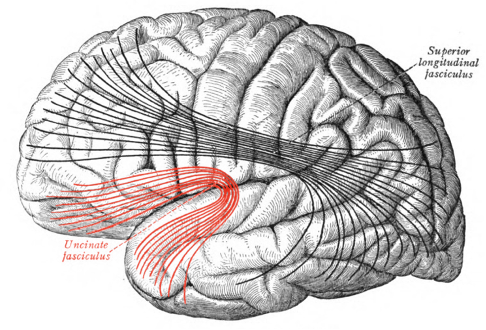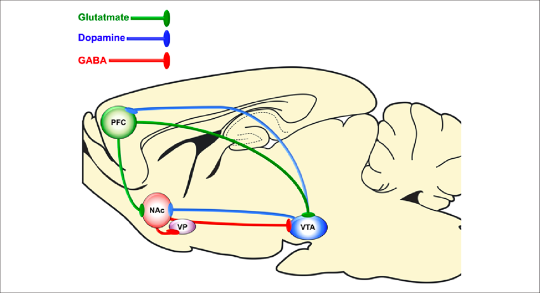Pathways between prefrontal cortex and the amygdala and accumbens: Implications for the neuroscience of experiential education from anxiety/fear to pleasure/reward mechanisms.
Mecca Brooks UA’22 and Jim Stellar
This blog follows up on a very recent blog from our group on implications of thinking in clinical psychology for experiential education. Those implications began in a slightly earlier blog on mindfulness and emotional regulation that itself began with an anatomical brain scan study, showing that subclinical anxiety was higher in human subjects with weaker anatomical connections between the prefrontal cortex (PFC) and amygdala. That study implied somewhat less cognitive or executive function control over amygdala mediated fear and anxiety. However, there is another pathway from the PFC that goes to the nucleus accumbens, a limbic system structure that is involved with pleasure and drug addictions.
In this blog, we will review these two pathways in a bit more detail and propose that they are the two limbic system informers to the cognitive planner that is involved in many decisions including how direct experience informs the career choice and commitment of college students engaging in internships. We see this thinking as being important given that we conscious human beings do not have cognitive access to the computations done in the limbic system, even if those limbic structures inform our thinking of their output through feelings. Consider the potential student statement, “I loved my internship in pediatrics and now see a possible career path in medicine.”
The fear/anxiety limbic channel: The uncinate fasciculus, as shown in red in the diagram below, is the major pathway from PFC to the temporal lobe where the amygdala resides with its long history of being involved in fear-learning and anxiety. Also note in the diagram another major pathway shown in black

that connects the PFC to the sensory areas in the back of the brain and may be involved with default mode network and mind-wandering, thinking about self and others, etc, however we will not explore this pathway here. The question here is whether the uncinate fasciculus might provide the kind of neural pathway for conscious-unconscious integration that we believe is important clinically and in normal college students processing the impact of experiential education on their college experience with a chosen field. This integration depends on the exact connections of the amygdala and the regions of the prefrontal cortex (PFC).
In general, the PFC-amygdala pathway involves the basolateral nuclei of the amygdala (BLA), which sends excitatory signals to GABAergic neurons in the PFC according to a recent study in animals. These GABAergic neurons, further, regulate PFC output to the BLA through a series of connections. Previous research also in animals has suggested that when GABA is enhanced in the PFC, the amygdala shows hyperactivity and anxiety (Pizzi, et al., 2017). Thus it makes sense that the PFC and amygdala in humans tend to be in opposite states of relative fMRI activation and quiescence with each other. Eden, et al. (2015), furthers this PFC amygdala interaction point by suggesting from human brain scan anatomical studies, that when individuals have strong connections between the amygdala and the PFC, they are less likely to experience sub-clinical anxiety, something we also noted previously from other human brain-scan anatomical studies. On the other hand, when connections in this pathway are weak (perhaps due to weak connections in the GABA system), the PFC may be unable to adequately control the amygdala, and thus is unable to appropriately regulate negative emotional stimuli. This dysregulation has implications in disabling impulse control, stress-hormone control, and behavioral control; all areas in which disordered anxiety arise (Burghy, et al., 2012). In any case, we see this interaction as a way the limbic system raises warnings with the cognitive system based on its limbic learning.
The pleasure/reward limbic channel: A PFC-nucleus accumbens pathway could allow the PFC to influence the positive limbic processing to go to the pleasure/reward other side of the emotional continuum. We took the diagram below from an animal research study as there is much work here on addiction and less work on the kind of anatomical study in humans as cited above. Notice the PFC projection to the nucleus accumbens (Nac) and the Ventral Tegmental area (VTA) uses the excitatory neurotransmitter glutamate.

To go a little deeper, in another blog some time ago, we wrote about the VTA’s dopamine neurons and specifically about how VTA firing is associated with cues that signal reward delivery even to the point that the VTA neurons stop firing to the delivery of a signaled reward but still fire to the cue. We interpreted this as a VTA phenomenon as limbic system computation, but now we wonder if that firing could be due to this projection. Does the PFC play the VTA-Accumbens dopamine projection like the piano player strikes the keys of the piano? If so, it is the cortex, not the lower systems that are making the connection. In any case, that would still make this system another example of cortical-limbic integration.
Taken together, could these two systems provide input to the judgements we write about as students learn from experience. What if a student goes on an internship in a law firm and finds their interactions with the lawyers there and the clients they take on to be highly positive. Perhaps the student sees the law as a vehicle of social justice and the lawyers as applying that law to achieve a good outcome. On the other hand, what if the student sees the lawyers as arrogant and practicing one-upmanship on each other and the corpus of the law as boring, like reading the dictionary. This early experience in college before applying to law school could be dramatic in shaping that student’s thinking about whether to go to law school. But it depends on having two limbic guard-rails that interact with a cognitive system so that when one or the other of those guard-rails is touched (or touches the student) they can feed that information into the cognitive systems of career choice and explanation of that choice to others.
A personal story from MB of being shaped by these two channels: Together, the anxiety/fear and pleasure/reward channels offer potential underlying mechanisms through which experimental education could function. When students are making decisions and plans for their future, these cognitive-emotional factors are likely used to inform the process. For example, my (MB) journey through my undergraduate years has featured many positive interactions in internships and research assistant positions that have immensely guided my career aspirations. Some have had negative experiences, but mine were positive.
I began mainly assisting with research in behavioral neuroscience laboratories; tasked with mapping out brain structures and counting activated cells in rodents. Working closely in these positions with university faculty and graduate students provided me with first-hand insight into what life is like for a career in academia and research. While I made positive connections with lab personnel, the animal models and laboratory procedures were aspects that I did not find appealing for an eventual career. Here, experiencing these laboratory opportunities led me to the realization that a path in behavioral neuroscience was not my interest and that my career aspirations were better in line with clinical psychology. With this new direction, I reached out to a laboratory at my University that had a focus in clinical psychology. When I started to work there I was unsure of whether this direction of study was the right path due to it being different from my previous experiences. However, as I started getting involved with projects and reading the relevant literature, I began to feel more confident in this direction. Further, collaborating with Dr. Stellar to study the literature of the clinical relevance of neural pathways (as such in this current blog), has further solidified my interest in continuing the clinical route.
I now see that when I as a student approached a new opportunity to change goals and direction, uncertainty and anxiety influenced the way this opportunity felt (the pathway between the PFC and the amygdala). When I was able to do good work in the new field, I had the rewarding experience of discovery and success (the pathway between the PFC and the VTA). Both were important as I sorted out what was my direction for post-graduate work.
